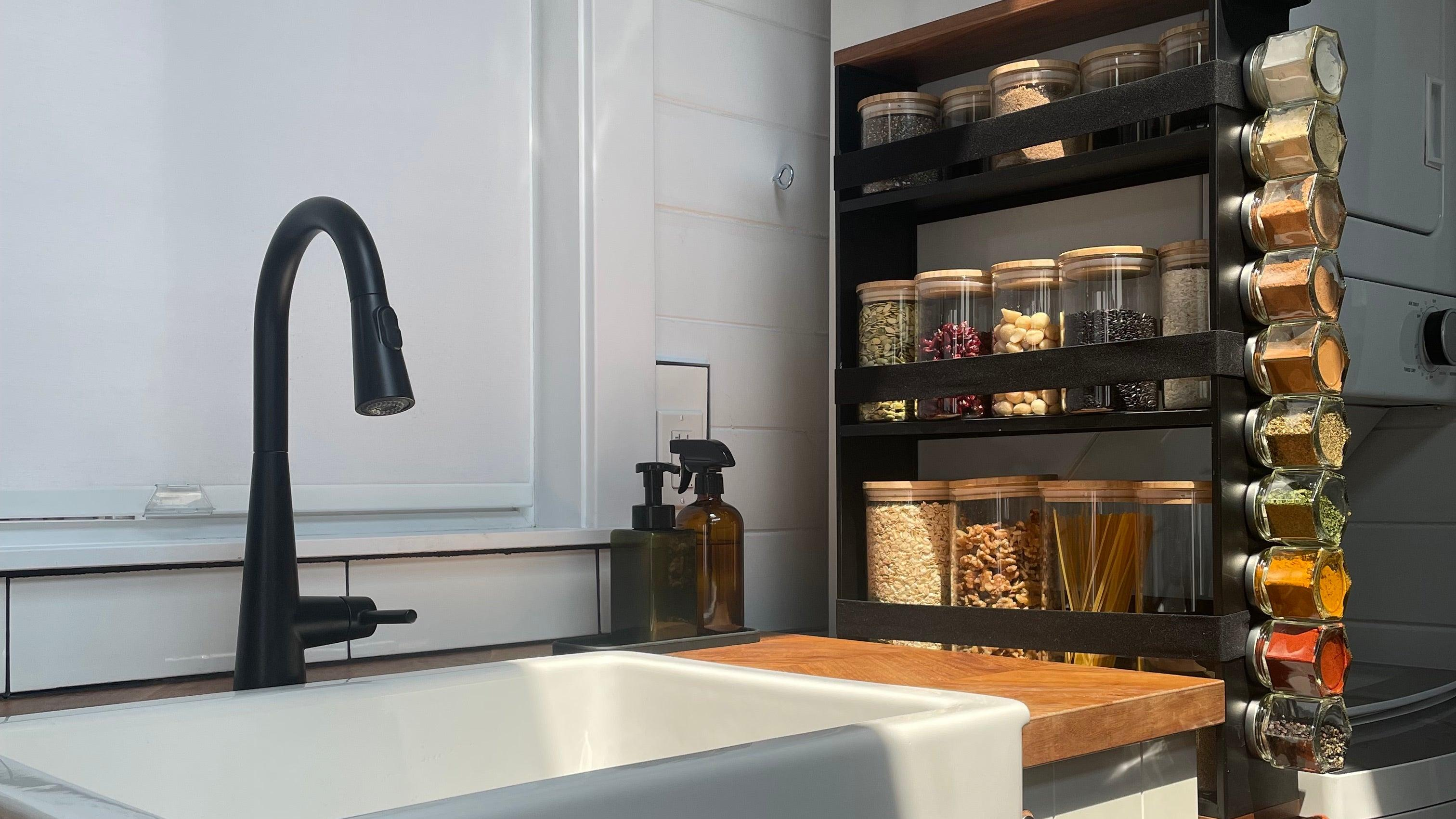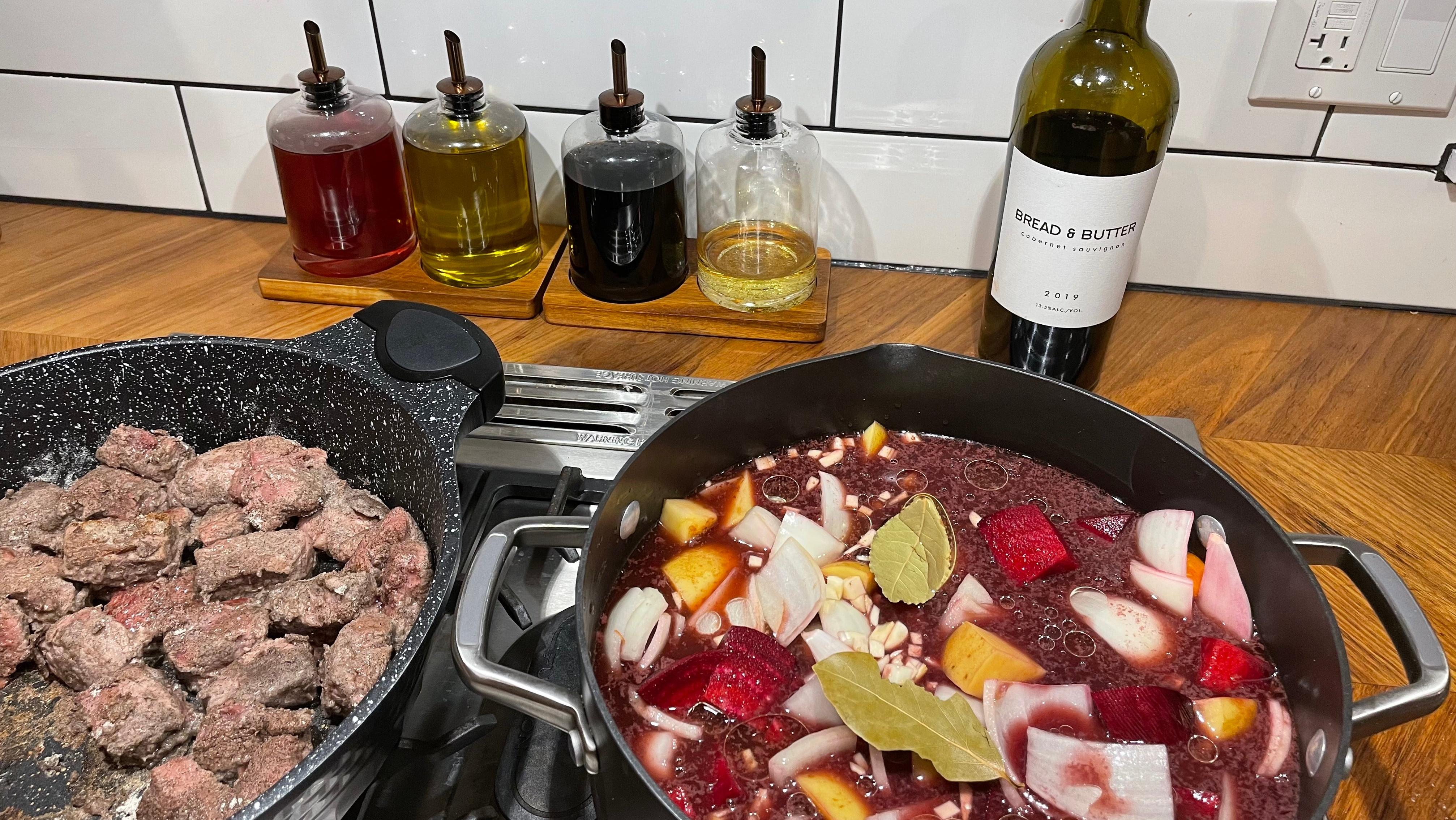Tiny Houses, Big Meals: How To Make The Most Of A Small Kitchen
Tiny home chefs offer tips for keeping a small cooking space organized.
For some home chefs, a dream kitchen has endless counter space, multiple burners, plenty of storage for new spices and gadgets, room to contain every impulsive purchase and serve as the prep station for the most complicated of recipes. But for home chefs who find themselves in tiny houses, the old adage rings true: less is more. And a look into their lifestyles offers plenty of tips for how to make the most out of a small kitchen in any setting.
Sage and Kaius Onawa (@a_u_d_nomadic on Instagram) are currently based in New Mexico and have over the years lived in several versions of a tiny house, ranging from an actual cabin to a school bus to a van, and the kitchen is always their first priority. The pair has even fashioned their Honda Element into a mini-camper with its own kitchen. "The meal in our home is the center of everything, the center of our relationship, our health, what we plan around," Kaius says. "Food and our kitchen is our most important thing."
Alaska Wagoner (@tinyhouseconcierge on Instagram) has been living in a tiny home in Boulder, Colorado for just about a year and quickly learned one lesson: "The tiny house teaches you how to live." An avid chef, she was initially worried about her square footage (and her addiction to bulk shopping at Costco) but in no time was able to downsize into a space that focuses on function and beauty.
There seems to be a common theme to the reasons for living in these tiny spaces: to spend more time focused on living and less time on the minutiae that distracts in the day-to-day. In the kitchen that means minimizing clutter and clean-up to turn your attention to what really matters: the food. Whether your tiny kitchen is in a studio apartment, a basement, an office, a dorm, or, like these folks, a tiny house, these tips and tricks will help you stay organized, reduce waste, and cook your best.
Keep only what you need
For the most part, you're not entertaining—you don't need a set of eight plates and bowls and glasses. The Onawas have just one plate, bowl, and set of silverware each. That philosophy carries over to cooking tools as well. Wagoner has just one knife for chopping and one serrated knife for cutting and suggests all you really need for your stove is a saucepan, frying pan, and pasta pot, adjusting recipes to be one-pot recipes when you can.
That doesn't mean you can't indulge in a few more complex items—just make sure it's something you actually use. For Wagoner, that's her waffle-maker. And for Sage Onawa, it's her Ninja Foodi, which does take up quite a bit of space on her counter, but because it serves multiple purposes including frying, baking, and roasting, it's well worth it.
All three of these tiny house dwellers suggest regularly purging kitchen items, Marie Kondo style. Wagoner does so on Instagram Live with a game called "25 things need to leave this tiny house right now." When she's done everything that's left not only serves a purpose, but brings her joy.
"There is no room for something that doesn't psych you up on life," she says. "It's a mini hit of endorphins every time I pull out this spatula."
Think about form and function
If you are lacking in cabinet space, an open shelving concept can help not only organize kitchenware and ingredients, but act as decoration in your home. Wagoner keeps her liquids and spices in plain sight, but uses stylish glass bottles behind her stove to store oils and vinegars, making those colors stand out.
She also turned a metal shelf on wheels into a mobile pantry that slides into a small space right next to her counter, pouring all her baking ingredients into glass canisters for the shelves and stocking spices in magnetic jars that stick to the side of the metal shelf. The result is a rainbow of flavor that's easy to grab and put back while cooking. Wagoner also relies on stackable kitchenware, like rainbow measuring cups, that condense space but also offer a pop of color.
Keep ingredients to a minimum
"We have certain foods we love eating so you want to plot around that," Kaius Onawa says. "It's about figuring out what you really like and really enjoy instead of going on impulse." For example, the Onawas have instilled a routine of having a pancake breakfast every Sunday, so they're always fully stocked with pancake ingredients, then plan out their meals for the week and shop to only those ingredients and a few staples, like onions, which they put in almost everything. This strategy not only saves space in the kitchen but cuts down on waste.
Don't be afraid to get creative when trying to stick to specific recipes. "I get the spices that I use a lot, and if I look at a recipe that has one or two things that are not what I have, I just modify the recipe," Wagoner says. "What is the purpose of this in the recipe, what could recreate that? You'll go crazy if you try to buy powdered parsley for one recipe."
Clean as you go
When working on a recipe, Wagoner suggests first prepping all your ingredients and then cleaning whatever tools you used for prep before beginning the cooking process. This helps reduce clutter in your small space as you go. As for after the meal, keeping your plates and cutlery to a minimum as the Onawas do forces you to wash your dishes before your next meal.
Especially in a tiny space, cleanliness is key to keep from attracting bugs or spreading bad odors. Wagoner keeps a tiny compost in her freezer for food scraps to neutralize any smells and keep her trash from overflowing into the little space she does have.
Embrace the chaos
If you're going for a big meal, sometimes you just have to accept that there will be moments when you'll have to spread out any way you can. "I have rested pasta sauces on the loft stairs while I'm meal prepping," Wagoner says. The Onawas often spread their prep and cleaning to the space outside of their van. But those moments are fleeting. When you're finished cooking a delicious meal, you can't taste the size of the kitchen it was cooked in.

